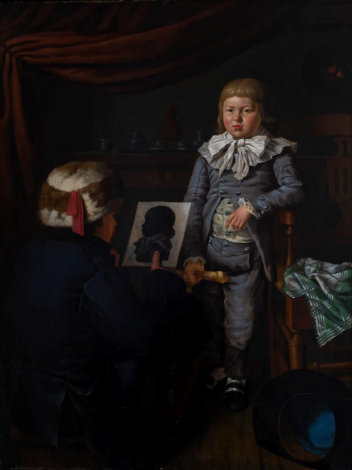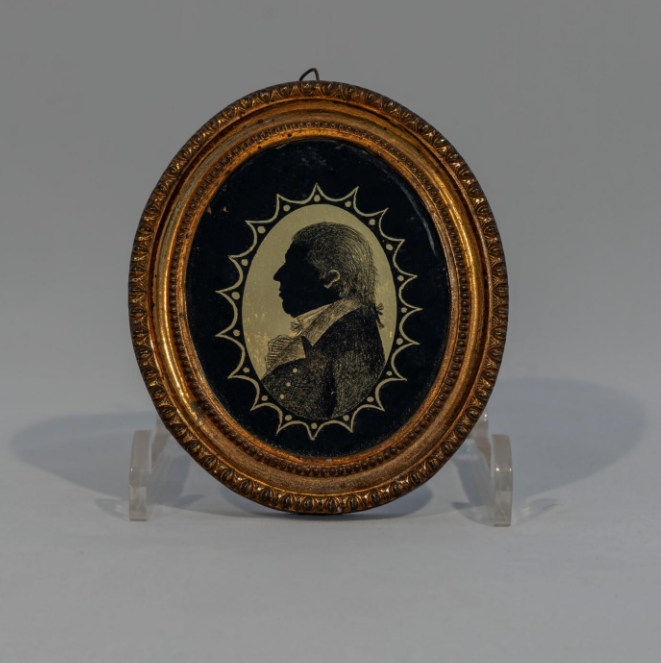Origin
The word silhouette is derived from the name of the French Minister of Finance, Étienne de Silhouette (1709-1767). He was highly skilled in creating small profile drawings, especially during meetings.

Silhouettes are painted, drawn, and cut. In this painting by Jacob Schwartzenbach (Veere 1763 – 1805 Veere), an artist paints a silhouette of a boy.
Popular
In the last quarter of the eighteenth and the first half of the nineteenth century, creating silhouette portraits becomes exceptionally popular. Originating in England, this trend spreads through French salons to Germany, the Netherlands, and the rest of Western Europe. Enthusiasts practice the art of silhouettes at home or in company, and traveling painters, drawers, and papercutters roam the country to portray interested individuals.

A special form of silhouettes is done with the ‘verre églomisé technique,’ where a design is applied as gilding on the back of a glass plate to create a mirror finish or by exposing the portrait in the gilded layer.
Cutting
Silhouettes lend themselves particularly well to being cut from paper. The Netherlands already has a tradition of paper cutting by the end of the eighteenth century. Works by enthusiasts and professional cutters adorn many rooms during that time, among the nobility, the bourgeoisie, and the common people alike. It is no surprise that paper cutters delve into the art of silhouettes.
During that period, there is no wide range of colored paper available. Profiles cut freehand are made from white paper and then painted black with Indian ink. Some cutters accentuate these black cuttings with white or colored paint to make the portrait more appealing.

Another way to bring a silhouette to life is by complementing affixed portraits with painted black details that are too delicate to cut. In that time, the Netherlands boasts a large number of enthusiasts practicing silhouette art. Their cut profiles often grace the alba amicorum (friendship albums) of their close ones and friends.
Additionally, professional cutters travel the country from the last quarter of the eighteenth century onward to generate extra income through silhouette cutting. In the Netherlands, many of them hail from Germany, promoting their services in local newspapers before their arrival. They often practice other forms of visual arts, such as painting, drawing, or etching. Notable Dutch silhouette cutters from that period include Joseph Adolf Schmetterling (1751-1828), Casparus Haanen (1778-1849), and Elisabeth Kiers-Haanen (1809-1845).
Paape

In the era when silhouette cutting becomes a true craze in Europe, the Dordrecht ceramic painter Gerrit Paape (1752-1803) publishes a booklet in 1792 titled ‘Beknopt en duidelijk onderwijs in het silhouëtteeren’ (Concise and Clear Instructions in Silhouetting). In 52 pages, he describes what it takes to create a lifelike profile and the necessary tools for it. He also pays attention to creating a shadow play using an illumination box and moving shadow figures. For the history of cut portraits and shadow play, this booklet holds significant importance.
Technical Aids

The popularity of silhouette cutting quickly leads to the development of technical aids to simplify the production of portraits. For those unable to draw profiles freehand, the silhouette chair is available. Users of this chair are primarily found in English seaside resorts where silhouette artists have more or less permanent workshops. In a silhouette chair, the shadow of the person to be portrayed falls onto a paper or cloth next to the chair, allowing the artist to trace it. The artist can then cut out the portrait or reduce it with a pantograph and then fill it in with black.
Printed Silhouettes
Technological advancements contribute to the ability to print silhouettes. With a pantograph, shadow portraits can be transferred to a printing plate, and the engraved silhouettes can be easily and inexpensively printed. As a result, various publications featuring the portraits of professors, ministers, and representatives appear around 1800. Later, with the introduction of lithography or stone printing, it becomes even easier to reproduce printed silhouettes in large quantities.
Competition
In the mid-nineteenth century, as photography emerges, silhouette art faces a formidable competitor. While silhouettes offer a quick and affordable way to acquire a portrait, the daguerreotype (precursor to the photograph) and photography provide a more realistic image. Once the prices of photography become more affordable, making it accessible to many, it marks the death knell for silhouettes.
Legacy
Among paper cutters, the art of silhouettes does not completely die out. Well into the 20th century, professional cutters create silhouette souvenirs of visitors at fairs, markets, and tourist resorts, all done while they pose.
In the second half of the 20th century, profile images experience a revival in the advertising world. The visual language of profile images is instantly recognizable for many people, which is why designers in an image-focused world often use profiles. While two centuries ago, this was mainly done with paint, scissors, and paper, most forms nowadays come from the computer.
Text: Janjaap Luijt, treasurer of the Association for Papercutting Art